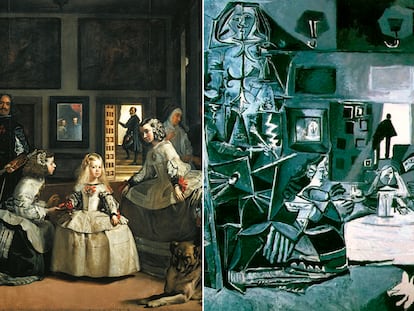Antonio López, a police expert in hunting down counterfeit works of art: ‘They’re sold as Picassos, but they’re really Pikachus’
Following the seizure of five works — including two attributed to Goya — in an operation involving five defendants, the director of Valencia’s Police Patrimony Unit explains how forgeries are detected
The owner of a purported Goya painting claimed that she had inherited the work from her grandfather. She showed a certificate and an appraisal that valued the small-format work at €1.5 to €1.8 million ($1.6 million to $1.9 million). She tried to sell it through an auction. The woman was arrested, released and investigated for the crimes of forgery and fraud. The painting, a scene from the War of Independence, is one of five works of art that are considered to be forgeries and were recently seized in Spain by the Valencian Police’s Patrimony Unit.
The forged pieces include Goya’s The Portrait of the Baron of Alcalalí, an Ecce Homo by Juan de Juanes (the pseudonym of Vicente Juan Macip), a Renoir and a Miró. All of the pieces had documentation attesting to their alleged authenticity and value. The estimated market value of the first three is over €2 million ($2.15 million), while the value of the other two is yet to be determined. But in reality, the forgeries are only worth a few hundred euros.
Four other owners are also under police investigation for fraud. This particular police unit rarely receives complaints and primarily acts by investigating commercial transactions, such as auctions. “The owner of a forged work does not report it; s/he wants to sell it, to get rid of it. It’s like the person who has a counterfeit bill,” explained Antonio López, of the Spanish National Police unit affiliated with Valencia’s police force, at a press conference presenting the seized works.
In the cases of the Miró and Renoir forgeries, the art dealer freely presented them to the Historical Patrimony group before marketing them in order to check if they appeared as stolen in the databases, as well as to check their authenticity and avoid committing a criminal offence. That is not the usual procedure, given that museums like the Prado do not certify authenticity or appraise artwork for private individuals. The owners of the portrait attributed to Goya were not art connoisseurs and said that they had acquired it in 1999 for €228,384.70 (around $245,000) as an investment, thinking it was an original work.
The profile of the buyer and seller varies, as does the quality of the forgery. In this sense, the low price of the seized Renoir is striking, as López himself noted. It is equally unusual that Juan de Juanes’s Ecce homo was done on canvas glued to a board, given that the originals on display at the Museum of Fine Arts in Valencia and in the Prado Museum were done directly on a board. Who pays a large amount of money to buy a work of art outside the safest channels for doing so, without all the guarantees that come with it? “It’s a swindle aided by a seal. Supported by false documentation, the seller can be very persuasive and can ultimately make you believe that it’s a bargain, if that’s what you want to believe... There is a lot of greed too,” López points out. There’s also a lot of money to launder and one of the ways to accomplish that is through the purchase of artworks, the policeman adds.
There are cases of buyers who have amassed a fortune but lack basic art knowledge and fall prey to their desire to have a piece by Pablo Picasso or Joaquín Sorolla (this year marks the centennial of the latter’s death) in their homes, López says. Thus, they acquire a work and when things go wrong they decide to sell it. Then the owner discovers that it is a fake and instead of filing a complaint, they attempt to sell the work as authentic.
López posed as a buyer in an operation in which police seized five Picassos, valued at €160 million ($171 million) a few years ago. “They were sold as Picassos, but they were Pikachus,” the policeman says with a smile. In 2014, López was working on his master’s degree in art when the Valencian unit was set up, and he was assigned to it. He recalls how the forgery of an impeccable-looking Modigliani was discovered after detecting that titanium white had been used after the Italian artist’s death in 1920.
Once a work is confiscated, the police turn to the experts, heirs and foundations that monitor an artist’s legacy to verify a piece’s authenticity and confirm their suspicions. “But judges and experts decide whether a work is a forgery or not, not us,” said Marisol Conde, Valencia’s Police Commissioner.
Conde joined councilwoman Elisa Núñez at a press conference that paid tribute to the policework. The event took place at the Museo Valenciano de la Ilustración y la Modernidad (Valencia’s Museum of Art and Modernity; MuVIM) on the occasion of the exhibition False: The Art of Deception or the Deception of Art?, which displays 112 works seized by the Valencian Police. Since 2014, this unit focused on patrimony has confiscated 6,143 art and cultural objects, of which 3,803 are archaeological pieces, 1,364 coins, 684 paintings and 157 sculptures, among other items.
Sign up for our weekly newsletter to get more English-language news coverage from EL PAÍS USA Edition
Tu suscripción se está usando en otro dispositivo
¿Quieres añadir otro usuario a tu suscripción?
Si continúas leyendo en este dispositivo, no se podrá leer en el otro.
FlechaTu suscripción se está usando en otro dispositivo y solo puedes acceder a EL PAÍS desde un dispositivo a la vez.
Si quieres compartir tu cuenta, cambia tu suscripción a la modalidad Premium, así podrás añadir otro usuario. Cada uno accederá con su propia cuenta de email, lo que os permitirá personalizar vuestra experiencia en EL PAÍS.
¿Tienes una suscripción de empresa? Accede aquí para contratar más cuentas.
En el caso de no saber quién está usando tu cuenta, te recomendamos cambiar tu contraseña aquí.
Si decides continuar compartiendo tu cuenta, este mensaje se mostrará en tu dispositivo y en el de la otra persona que está usando tu cuenta de forma indefinida, afectando a tu experiencia de lectura. Puedes consultar aquí los términos y condiciones de la suscripción digital.
More information
Archived In
Últimas noticias
Welcome to the post-religion era: The idea of Christianity as the absolute truth has become obsolete
‘I thought you would like it’: The risky sexual practice popularized by TV shows and TikTok
The digitalization of tourism: ‘They promise experiences and gave us the worst possible one’
Mexican peso defies uncertainty with forecasts of a new period of stability in 2026
Most viewed
- Sinaloa Cartel war is taking its toll on Los Chapitos
- Reinhard Genzel, Nobel laureate in physics: ‘One-minute videos will never give you the truth’
- Oona Chaplin: ‘I told James Cameron that I was living in a treehouse and starting a permaculture project with a friend’
- Why the price of coffee has skyrocketed: from Brazilian plantations to specialty coffee houses
- Silver prices are going crazy: This is what’s fueling the rally











































